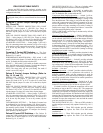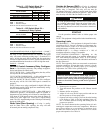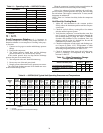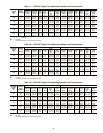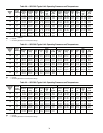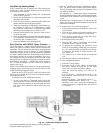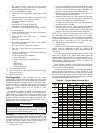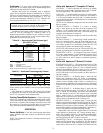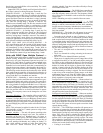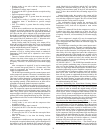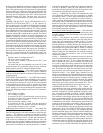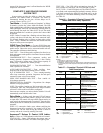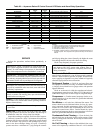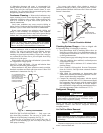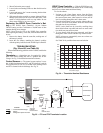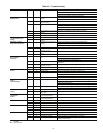
34
Speed relays are turned off after a 60-second delay. The control
reverts to Standby mode.
Output EH1, EH2, Fan Enable, and Fan Speed will be ON if
the G input is not active during Emergency Heat mode.
COOLING STAGE 1 — In Cooling Stage 1 mode, the Fan
Enable, compressor and RV relays are turned on immediately.
If configured as stage 2 (DIP switch set to OFF) then the com-
pressor and fan will not turn on until there is a stage 2 demand.
The fan Enable and compressor relays are turned off immedi-
ately when the Cooling Stage 1 demand is removed. The
control reverts to Standby mode. The RV relay remains on until
there is a heating demand. If there is a master/slave or dual
compressor application, all compressor relays and related func-
tions will track with their associated DIP switch 2 on S1.
COOLING STAGE 2 — In Cooling Stage 2 mode, the Fan
Enable, compressor and RV relays remain on. The Fan Speed
relay is turned on immediately and turned off immediately
once the Cooling Stage 2 demand is removed. The control re-
verts to Cooling Stage 1 mode. If there is a master/slave or dual
compressor application, all compressor relays and related func-
tions will track with their associated DIP switch 2 on S1.
NIGHT LOW LIMIT (NLL) STAGED HEATING — In
NLL staged Heating mode, the override (OVR) input becomes
active and is recognized as a call for heating and the control
will immediately go into a Heating Stage 1 mode. With an
additional 30 minutes of NLL demand, the control will go into
Heating Stage 2 mode. With another additional 30 minutes of
NLL demand, the control will go into Heating Stage 3 mode.
Units with WSHP Open Multiple Protocol —
The WSHP Open multi-protocol controller will control me-
chanical cooling, heating and waterside economizer outputs
based on its own space temperature input and set points. An
optional CO
2
IAQ (indoor air quality) sensor mounted in the
space can maximize the occupant comfort. The WSHP Open
controller has its own hardware clock that is automatically set
when the heat pump software is downloaded to the board. Oc-
cupancy types are described in the scheduling section below.
The following sections describe the functionality of the WSHP
Open multi-protocol controller. All point objects referred to in
this sequence of operation will be referenced to the objects as
viewed in the BACview
6
handheld user interface.
SCHEDULING — Scheduling is used to start/stop the unit
based on a time period to control the space temperature to spec-
ified occupied heating and cooling set points. The controller is
defaulted to control by occupied set points all the time, until ei-
ther a time schedule is configured with BACview
6
, Field Assis-
tant, i-Vu
®
Open, or a third party control system to enable/dis-
able the BAS (Building Automation System) on/off point. The
local time and date must be set for these functions to operate
properly. The occupancy source can be changed to one of the
following:
Occupancy Schedules
— The controller will be occupied 24/7
until a time schedule has been configured using either Field
Assistant, i-Vu Open, BACview
6
or a third party control system
to enable/disable the BAS on/off point. The BAS point can be
disabled by going to Config, then Unit, then Occupancy Sched-
ules and changing the point from enable to disable then click-
ing OK.
NOTE: This point must be enabled in order for the i-Vu Open,
Field Assistant, or BACview
6
control system to assign a time
schedule to the controller.
Schedule_schedule
— The unit will operate according to the
schedule configured and stored in the unit. The schedule is
accessible via the BACview
6
Handheld tool, i-Vu Open, or
Field Assistant control system. The daily schedule consists of a
start/stop time (standard or 24-hour mode) and seven days of
the week, starting with Monday and ending on Sunday. To
enter a daily schedule, navigate to Config, then Sched, then
enter BACview
6
Admin Password (1111), then go to
schedule_schedule. From here, enter either a Weekly or Excep-
tion schedule for the unit.
Occupancy Input Contact
— The WSHP Open controller has
the capability to use an external dry contact closure to deter-
mine the occupancy status of the unit. The Occupancy Sched-
ules will need to be disabled in order to utilize the occupancy
contact input.
NOTE: Scheduling can only be controlled from one source.
BAS (Building Automation System) On/Off
— A BAS
system that supports network scheduling can control the unit
through a network communication and the BAS scheduling
function once the Occupancy Schedules have been disabled.
NOTE: Scheduling can either be controlled via the unit or the
BAS, but not both.
INDOOR FAN — The indoor fan will operate in any one of
three modes depending on the user configuration selected.
Fan mode can be selected as Auto, Continuous, or Always
On. In Auto mode, the fan is in intermittent operation during
both occupied and unoccupied periods. Continuous fan mode
is intermittent during unoccupied periods and continuous dur-
ing occupied periods. Always On mode operates the fan con-
tinuously during both occupied and unoccupied periods. In the
default mode, Continuous, the fan will be turned on whenever
any one of the following is true:
• The unit is in occupied mode as determined by its occu-
pancy status.
• There is a demand for cooling or heating in the unoccu-
pied mode.
• There is a call for dehumidification (optional).
When power is reapplied after a power outage, there will be
a configured time delay of 5 to 600 seconds before starting the
fan. There are also configured fan delays for Fan On and Fan
Off. The Fan On delay defines the delay time (0 to 30 seconds;
default 10) before the fan begins to operate after heating or
cooling is started while the Fan Off delay defines the delay
time (0 to 180 seconds; default 45) the fan will continue to op-
erate after heating or cooling is stopped. The fan will continue
to run as long as the compressors, heating stages, or the dehu-
midification relays are on. If the SPT failure alarm or conden-
sate overflow alarm is active; the fan will be shut down imme-
diately regardless of occupancy state or demand.
Fan Speed Control (During Heating)
— Whenever heat is re-
quired and active, the control continuously monitors the sup-
ply-air temperature to verify it does not rise above the config-
ured maximum heating SAT limit (110 F default). As the SAT
approaches this value, the control will increase the fan speed as
required to ensure the SAT will remain within the limit. This
feature provides the most quiet and efficient operation by oper-
ating the fan at the lowest speed possible.
Fan Speed Control (During Cooling)
— Whenever mechani-
cal cooling is required and active, the control continuously
monitors the supply-air temperature to verify it does not fall be-
low the configured minimum cooling SAT limit (50 F default).
As the SAT approaches this value, the control will increase the
fan speed as required to ensure the SAT will remain within the
limit. The fan will operate at lowest speed to maximize latent
capacity during cooling.
COOLING — The WSHP Open controller will operate one or
two stages of compression to maintain the desired cooling set
point. The compressor outputs are controlled by the PI (propor-
tional-integral) cooling loop and cooling stages capacity algo-
rithm. They will be used to calculate the desired number of
stages needed to satisfy the space by comparing the space tem-
perature (SPT) to the appropriate cooling set point. The water
side economizer, if applicable, will be used for first stage cool-
ing in addition to the compressor(s). The following conditions
must be true in order for the cooling algorithm to run:
• Cooling is set to Enable.



